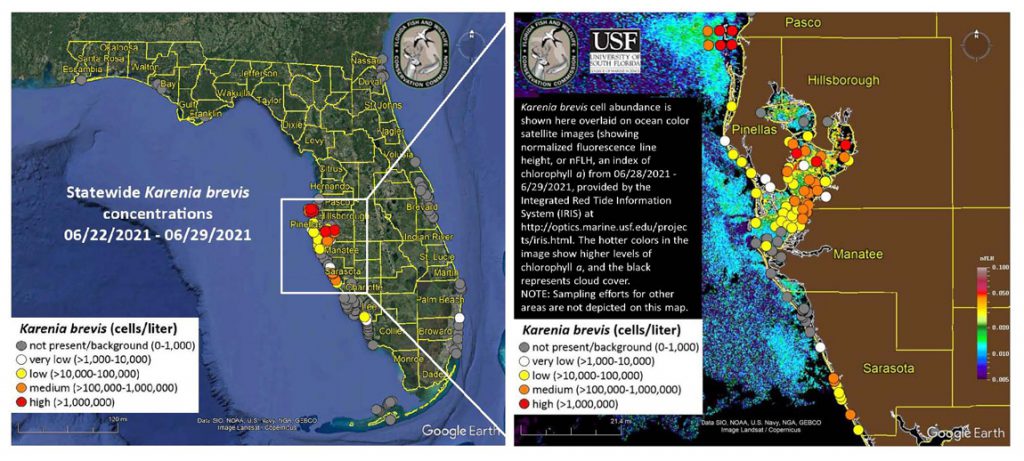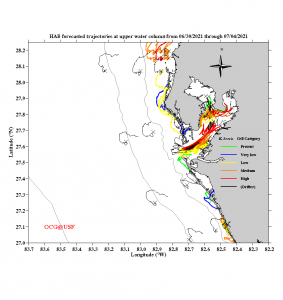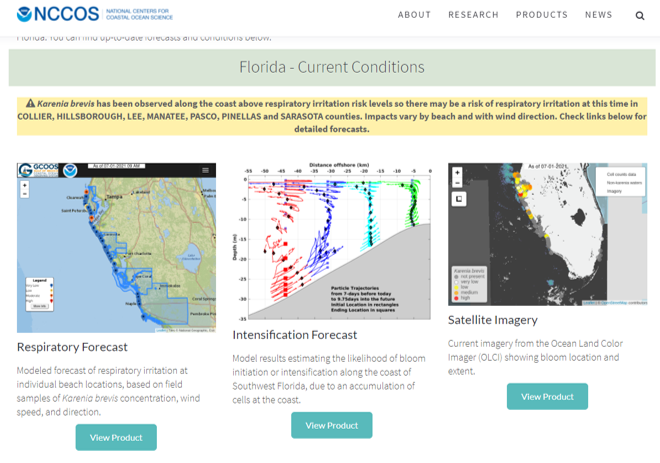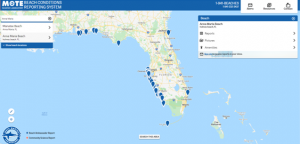For a quick list of links to current red tide conditions, scroll to the end!
First published September 2018. Last updated July 19, 2021.

We get a lot of questions about red tide in southwest Florida…especially during blooms. A Google search can be overwhelming and it may be tough to know where to start or how to interpret the results. While this post is not intended to be a comprehensive overview of all red tide research, here are a few of the most informative websites. Bookmark them for easy access to status and forecasting of red tide events.
The Florida Fish and Wildlife Conservation Commission Fish and Wildlife Research Institute has an entire team of scientists dedicated to research and monitoring of harmful algal blooms (HABs). They also coordinate a volunteer program that helps provide greater sampling coverage throughout the year. FWC provides regular updates on current red tide status for the state of Florida.
FWC also has multiple resources online related to the biology and history of Florida’s red tide: Red Tide FAQs. For those wishing to dive deeper into the science, multiple research papers are available in FWRI’s digital library.

Ocean Circulation Group models red tide transport. This collaborative effort between USF and FWRI provides us with an up-to-date idea of what conditions can be expected in the near future.
The University of South Florida’s College of Marine Science Ocean Circulation Group models the transport of bloom conditions at the surface and bottom of the water column. Their interactive map provides predictions for where red tide is headed based on water circulation patterns and bloom conditions. This collaborative effort between USF and FWRI combines the expertise of oceanographers and biologists to provide us with an up-to-date idea of what conditions can be expected in the near future.
Harmful algal blooms are also tracked at the federal level, and NOAA offers multiple resources with red tide information. The National Centers for Coastal Ocean Science provide information including respiratory forecasts, intensification trajectories and satellite imagery of blooms for the Gulf of Mexico. NOAA is also enhancing their HAB forecast models for the public and have created a Gulf of Mexico dashboard (coming soon in August 2021).

Mote Marine Lab established The Red Tide Institute in 2018 with the following mission: “Reducing adverse impacts of Florida red tide on public health, coastal marine ecosystems and Florida’s economy via the rigorous testing and application of a “tool box” of science-based mitigation and control technologies and strategies. Check out their current research projects, including assessment of potential mitigation strategies and factors contributing to bloom expansion.
Red tide is patchy and the beach might be ok one day and not the next.

Just because there is a bloom in Florida doesn’t mean you need to cancel your travel plans. Bloom conditions may change rapidly from one day to the next. Mote Marine Lab also maintains a website dedicated to keeping up with local beach conditions that you can check before you head out.
The Florida Department of Environmental Protection (FDEP) also compiles information on local conditions, including water quality data and harmful algal blooms, on a state dashboard: Protecting Florida Together.
Want to be more involved? The Gulf of Mexico Coastal Ocean Observing System (GCOOS) recently developed HABscope, a citizen science program dedicated to gathering data from trained volunteers to allow for more robust red tide forecasts.
The 2018 – 2019 Red Tide bloom stacked up to be one of the worst blooms on record. (See this summary by the Science and Environment Council regarding impacts in Tampa Bay and Sarasota Bay.) Extended red tides are devastating for local communities and tough on coastal economies. It is heart-breaking to observe the impact on marine life and working waterfronts. But it is important to remember that severe red tide blooms have happened before, and although it takes some time, the marine ecosystem typically recovers. It can be a helpless feeling to watch something like this take place, but it helps to stay informed and know that there are multiple agencies and a lot of people focused on red tide research, future prediction and potential solutions.
We are lucky to live in a time where so many digital resources are available to keep us informed. That is one small consolation during these devastating blooms. Stay informed and keep tabs on the good science that is out there, which continues to develop and improve our understanding every day.
Quick list of links to current conditions:
- Current red tide status and FWC daily sample map
- Ocean Circulation Group Prediction Models and Red Tide Tracking
- NOAA NCCOS Harmful Algal Bloom Conditions Report
- Mote HAB Observatory: Local Beach Conditions
- FDEP Protecting Florida Together statewide dashboard for water quality
- Florida Department of Health HAB Information
- GCOOS HABscope
- TBEP Piney Point Environmental Monitoring Dashboard
Additional resources:
- Science and Environment Council. 2020. 2018 Red Tide Impact and Response.
- Kirkpatrick, B. et al. 2004. Literature Review of Florida Red Tide: Implications for Human Health Effects. Harmful Algae 3: 99 – 115.
- Florida Sea Grant. 2018. Understanding Florida’s Red Tide.
- Florida Sea Grant. 2019. State of the Science for Harmful Algal Blooms in Florida.
- Florida Sea Grant. 2020. Developing a Communications Strategy for Red Tide in Florida.
- For a wealth of data as related to water resources in Florida, check out wateratlas.org
For a similar blog about cyanobacteria (blue green algae) blooms, check out: Resources for understanding blue-green algae (cyanobacteria) blooms.
 1
1
